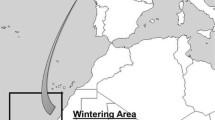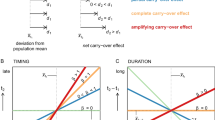Abstract
Life history theory suggests a trade-off between costly activities such as breeding and migration and somatic self-maintenance. However, how the short-term cost of parental effort is expressed in species with a slow pace-of-life is not well understood. Also, investigating carry-over effects of migration is most meaningful when comparing migratory strategies within the same population, but this has rarely been done. We explore this hypothesis in a long-lived, pelagic seabird, the Cory’s Shearwater, Calonectris borealis, where males display partial migration. By manipulating reproductive effort and taking advantage of the natural variation in migratory strategy, we investigate whether early reproductive failure and migratory strategy had implications on the physical condition of males on return to the colony the following year. We experimentally induced breeding failure from mid-incubation, tracked the over-winter movements of these males and of males that invested in parental effort, and assessed innate immunity, stress, and residual body mass the following year. Early breeding failure resulted in earlier return to the colony among all males, associated with greater probability of reproductive success. Residents had a lower tail feather fault bar intensity, an indicator of stress during the non-breeding period, compared to migrants. Reproductive effort and migratory strategy had no impact on physiological condition otherwise. Our results provide evidence that in species with a slow-pace of life, such as the Cory’s Shearwater, somatic maintenance is prioritised, with the costs of reproduction and migration paid in delayed arrival date.




Similar content being viewed by others
References
Alonso H, Matias R, Granadeiro JP, Catry P (2009) Moult strategies of Cory’s Shearwaters Calonectris diomedea borealis: the influence of colony location, sex and individual breeding status. J Ornithol 150:329–337. https://doi.org/10.1007/s10336-008-0354-2
Bauch C, Gatt MC, Granadeiro JP et al (2020) Sex-specific telomere length and dynamics in relation to age and reproductive success in Cory’s Shearwaters. Mol Ecol 29:1344–1357. https://doi.org/10.1111/mec.15399
Berzins LL, Gilchrist HG, Matson KD, Burness G (2011) Sex-specific effects of increased incubation demand on innate immunity in Black Guillemots. Physiol Biochem Zool 84:222–229. https://doi.org/10.1086/658373
Bodey TW, Cleasby IR, Bell F et al (2017) A phylogenetically controlled meta-analysis of biologging device effects on birds: deleterious effects and a call for more standardized reporting of study data. Methods Ecol Evol 9:946–955. https://doi.org/10.1111/ijlh.12426
Bogdanova MI, Daunt F, Newell M et al (2011) Seasonal interactions in the Black-legged Kittiwake, Rissa tridactyla: links between breeding performance and winter distribution. Proc R Soc B Biol Sci 278:2412–2418. https://doi.org/10.1098/rspb.2010.2601
Boonekamp JJ, Dijkstra R, Dijkstra C, Verhulst S (2017) Canalization of development reduces the utility of traits as fitness biomarkers: feather fault bars in nestling birds. Funct Ecol 31:719–727. https://doi.org/10.1111/1365-2435.12765
Bortolotti GR, Dawson RD, Murza GL (2002) Stress during feather development predicts fitness potential. J Anim Ecol 71:333–342. https://doi.org/10.1046/j.1365-2656.2002.00602.x
Bortolotti GR, Marchant T, Blas J, Cabezas S (2009) Tracking stress: localisation, deposition and stability of corticosterone in feathers. J Exp Biol 212:1477–1482. https://doi.org/10.1242/jeb.022152
Bourgeon S, Leat EHK, Magnusdóttir E et al (2014) Feather corticosterone levels on wintering grounds have no carry-over effects on breeding among three populations of Great Skuas (Stercorarius skua). PLoS ONE 9:1–6. https://doi.org/10.1371/journal.pone.0100439
Buehler DM, Piersma T (2008) Travelling on a budget: predictions and ecological evidence for bottlenecks in the annual cycle of long-distance migrants. Philos Trans R Soc B Biol Sci 363:247–266. https://doi.org/10.1098/rstb.2007.2138
Buehler DM, Tieleman BI, Piersma T (2010) How do migratory species stay healthy over the annual cycle? A conceptual model for immune function and for resistance to disease. Integr Comp Biol 50:346–357. https://doi.org/10.1093/icb/icq055
Burnham KP, Anderson DR (2002) Model selection and multimodel inference: a practical information-theoretic approach, 2nd edn. Springer, New York, New York
Catry P, Dias MP, Phillips RA, Granadeiro JP (2011) Different means to the same end: long-distance migrant seabirds from two colonies differ in behaviour, despite common wintering grounds. PLoS ONE 6:4–9. https://doi.org/10.1371/journal.pone.0026079
Catry P, Dias MP, Phillips RA, Granadeiro JP (2013) Carry-over effects from breeding modulate the annual cycle of a long-distance migrant: an experimental demonstration. Ecology 94:1230–1235. https://doi.org/10.1890/12-2177.1
Chapman BB, Brönmark C, Nilsson J-Å, Hansson L-A (2011) The ecology and evolution of partial migration. Oikos 120:1764–1775. https://doi.org/10.1111/j.1600-0706.2011.20131.x
Cherel Y, Quillfeldt P, Delord K et al (2016) Combination of at-sea activity, geolocation and feather stable isotopes documents where and when seabirds molt. Front Ecol Evol. https://doi.org/10.3389/fevo.2016.00003
Cohen AA, Mauck RA, Wheelwright NT et al (2009) Complexity in relationships between antioxidants and individual life-history parameters in a seabird and a songbird. Oikos 118:1854–1861. https://doi.org/10.1111/j.1600-0706.2009.17785.x
Dias MP, Granadeiro JP, Catry P (2013) Individual variability in the migratory path and stopovers of a long-distance pelagic migrant. Anim Behav. https://doi.org/10.1016/j.anbehav.2013.05.026
Dias MP, Granadeiro JP, Catry P (2012a) Working the day or the night shift? Foraging schedules of Cory’s shearwaters vary according to marine habitat. Mar Ecol Prog Ser 467:245–252. https://doi.org/10.3354/meps09966
Dias MP, Granadeiro JP, Catry P (2012b) Do seabirds differ from other migrants in their travel arrangements? On route strategies of Cory’s Shearwater during its trans-equatorial journey. PLoS ONE 7:e49376. https://doi.org/10.1371/journal.pone.0049376
Dias MP, Granadeiro JP, Phillips RA et al (2011) Breaking the routine: individual Cory’s shearwaters shift winter destinations between hemispheres and across ocean basins. Proc R Soc B Biol Sci 278:1786–1793. https://doi.org/10.1098/rspb.2010.2114
Fayet AL, Freeman R, Shoji A et al (2016) Carry-over effects on the annual cycle of a migratory seabird: an experimental study. J Anim Ecol 85:1516–1527. https://doi.org/10.1111/1365-2656.12580
Gilmour ME, Lattin CR, Romero LM et al (2014) Finding the best predictor of reproductive performance of Leach’s Storm-Petrels. Auk 132:191–205. https://doi.org/10.1642/auk-14-21.1
Gómez-Díaz E, Navarro J, González-Solís J (2008) Ectoparasite community structure on three closely related seabird hosts: a multiscale approach combining ecological and genetic data. Ecography (Cop) 31:477–489. https://doi.org/10.1111/j.0906-7590.2008.05330.x
Granadeiro JP, Dias MP, Rebelo R et al (2006) Numbers and population trends of Cory’s Shearwater Calonectris diomedea at Selvagem Grande, Northeast Atlantic. Waterbirds 29:56–60. https://doi.org/10.1675/1524-4695(2006)29[56:naptoc]2.0.co;2
Green AJ (2001) Mass/length residuals: measures of body condition or generators of spurious results? Ecology 82:1473–1483. https://doi.org/10.1890/0012-9658(2001)082[1473:MLRMOB]2.0.CO;2
Harrison XA, Blount JD, Inger R et al (2011) Carry-over effects as drivers of fitness differences in animals. J Anim Ecol 80:4–18. https://doi.org/10.1111/j.1365-2656.2010.01740.x
Hegemann A, Marra PP, Tieleman BI (2015) Causes and consequences of partial migration in a passerine bird. Am Nat 186:531–546. https://doi.org/10.1086/682667
Hegemann A, Matson KD, Both C, Tieleman BI (2012) Immune function in a free-living bird varies over the annual cycle, but seasonal patterns differ between years. Oecologia 170:605–618. https://doi.org/10.1007/s00442-012-2339-3
Hegemann A, Matson KD, Flinks H, Tieleman BI (2013) Offspring pay sooner, parents pay later: experimental manipulation of body mass reveals trade-offs between immune function, reproduction and survival. Front Zool. https://doi.org/10.1186/1742-9994-10-77
Inger R, Harrison XA, Ruxton GD et al (2010) Carry-over effects reveal reproductive costs in a long-distance migrant. J Anim Ecol 79:974–982. https://doi.org/10.1111/j.1365-2656.2010.01712.x
Jovani R, Rohwer S (2016) Fault bars in bird feathers: mechanisms, and ecological and evolutionary causes and consequences. Biol Rev 92:1113–1127. https://doi.org/10.1111/brv.12273
Koolhaas J, Korte S, De Boer S et al (1999) Coping styles in animals: current status in behavior and stress-physiology. Neurosci Biobehav Rev 23:925–935. https://doi.org/10.1016/S0149-7634(99)00026-3
Lee KA (2006) Linking immune defenses and life history at the levels of the individual and the species. Integr Comp Biol 46:1000–1015. https://doi.org/10.1093/icb/icl049
Matson KD, Horrocks NPC, Versteegh MA, Tieleman BI (2012) Baseline haptoglobin concentrations are repeatable and predictive of certain aspects of a subsequent experimentally-induced inflammatory response. Comp Biochem Physiol Part A Mol Integr Physiol 162:7–15. https://doi.org/10.1016/j.cbpa.2012.01.010
Matson KD, Ricklefs RE, Klasing KC (2005) A hemolysis-hemagglutination assay for characterizing constitutive innate humoral immunity in wild and domestic birds. Dev Comp Immunol 29:275–286. https://doi.org/10.1016/j.dci.2004.07.006
Møller AP, Szép T (2011) The role of parasites in ecology and evolution of migration and migratory connectivity. J Ornithol 152:1–10. https://doi.org/10.1007/s10336-010-0621-x
Mougin J-L, Jouanin C, Roux F (1997) Intermittent breeding in Cory’s Shearwater Calonectris diomedea of Selvagem Grande, North Atlantic. Ibis (Lond 1859) 139:40–44. https://doi.org/10.1111/j.1474-919X.1997.tb04502.x
Nwaogu CJ, Cresswell W, Versteegh MA, Tieleman BI (2019) Seasonal differences in baseline innate immune function are better explained by environment than annual cycle stage in a year-round breeding tropical songbird. J Anim Ecol 88:537–553. https://doi.org/10.1111/1365-2656.12948
Owen-Ashley NT, Wingfield JC (2007) Acute phase responses of passerine birds: characterization and seasonal variation. J Ornithol 148:583–591. https://doi.org/10.1007/s10336-007-0197-2
Perez C, Granadeiro JP, Dias MP et al (2014) When males are more inclined to stay at home: insights into the partial migration of a pelagic seabird provided by geolocators and isotopes. Behav Ecol 25:313–319. https://doi.org/10.1093/beheco/art119
Pérez C, Granadeiro JP, Dias MP, Catry P (2016) Sex and migratory strategy influence corticosterone levels in winter-grown feathers, with positive breeding effects in a migratory pelagic seabird. Oecologia 181:1025–1033. https://doi.org/10.1007/s00442-016-3625-2
Péron C, Delord K, Phillips RA et al (2010) Seasonal variation in oceanographic habitat and behaviour of white-chinned petrels Procellaria aequinoctialis from Kerguelen Island. Mar Ecol Prog Ser 416:267–284. https://doi.org/10.3354/meps08785
R Core Team (2019) R: a language and environment for statistical computing. R Foundation for Statistical Computing, Vienna, Austria
Ramos JA, Monteiro LR, Sola E, Moniz Z (1997) Characteristics and competition for nest cavities in burrowing Procellariiformes. Condor 99:634–641. https://doi.org/10.2307/1370475
Ramos R, Llabrés V, Monclús L et al (2018) Costs of breeding are rapidly buffered and do not affect migratory behavior in a long-lived bird species. Ecology 99:2010–2024. https://doi.org/10.1002/ecy.2435
Ricklefs RE, Wikelski M (2002) The physiology/life-history nexus. Trends Ecol Evol 17:462–468. https://doi.org/10.1016/S0169-5347(02)02578-8
Rowe L, Ludwig D, Schluter D (1994) Time, condition, and the seasonal decline of avian clutch size. Am Nat 143:698–722. https://doi.org/10.2307/2462907
Santos ESA, Nakagawa S (2012) The costs of parental care: a meta-analysis of the trade-off between parental effort and survival in birds. J Evol Biol 25:1911–1917. https://doi.org/10.1111/j.1420-9101.2012.02569.x
Selman C, Blount JD, Nussey DH, Speakman JR (2012) Oxidative damage, ageing, and life-history evolution: where now? Trends Ecol Evol 27:570–577. https://doi.org/10.1016/j.tree.2012.06.006
Sild E, Hõrak P (2009) Nitric oxide production: an easily measurable condition index for vertebrates. Behav Ecol Sociobiol 63:959–966. https://doi.org/10.1007/s00265-009-0710-0
Stearns SC (1992) The evolution of life histories. Oxford Univeristy Press, London
Versteegh MA, Helm B, Kleynhans EJ et al (2014) Genetic and phenotypically flexible components of seasonal variation in immune function. J Exp Biol 217:1510–1518. https://doi.org/10.1242/jeb.097105
Zino PA, Zino F, Maul T, Biscoito JM (1987) The laying, incubation and fledging periods of Cory’s Shearwater Calonectris diomedea borealis on Selvagem Grande in 1984. Ibis (Lond 1859) 129:393–398. https://doi.org/10.1111/j.1474-919X.1987.tb03185.x
Acknowledgements
We are grateful to Filipe Moniz, Pedro Melo, and all helpers for assistance in the field in this long-term project, Merijn Driessen for support in the lab at the Groningen Institute for Evolutionary Life Sciences, and Sara Pardal for advice in early planning. Instituto das Florestas e da Conservação da Natureza gave permissions and support for the work on Selvagem Grande. Procedures were approved by ISPA’s Ethical Committee for Animal Welfare and carried out under licenses issued by the DGAV (Direção Geral de Alimentação e Veterinária), license number DGAV 0421/2017, and by the Instituto das Florestas e da Conservação da Natureza, IFCN licence 1/S (2017). Funding was provided by the Fundação para a Ciência e a Tecnologia (FCT, Portugal) through projects Seamigrant PTDC/BIA-ANM/3743/2014 and Oceanwebs (PTDC/MARPRO/0929/2014), and PD/BD/127807/2016 awarded to MCG. Thanks are due for the financial support to CESAM (UIDB/50017/2020 and UIDP/50017/2020) and MARE (UIDB/04292/2020 and UIDP/04292/2020) by FCT, Portugal.
Author information
Authors and Affiliations
Contributions
PC and JPG conceived the long-term monitoring scheme. MCG, PC and JPG developed the ideas and designed the study. MCG and CB carried out the fieldwork. MCG led the writing of the manuscript. BIT provided logistical support for the analyses of immune parameters. MCG and MAV analysed and interpreted the immune data. All authors contributed critically to the drafts and gave final approval for publication.
Corresponding author
Additional information
Communicated by Thomas Koert Lameris.
This paper advances the knowledge of how K-strategists balance costly annual cycle activities with self-maintenance. Migratory strategies have scarcely been compared at an intra-population level.
Electronic supplementary material
Below is the link to the electronic supplementary material.
Rights and permissions
About this article
Cite this article
Gatt, M.C., Versteegh, M., Bauch, C. et al. Costs of reproduction and migration are paid in later return to the colony, not in physical condition, in a long-lived seabird. Oecologia 195, 287–297 (2021). https://doi.org/10.1007/s00442-020-04775-w
Received:
Accepted:
Published:
Issue Date:
DOI: https://doi.org/10.1007/s00442-020-04775-w




